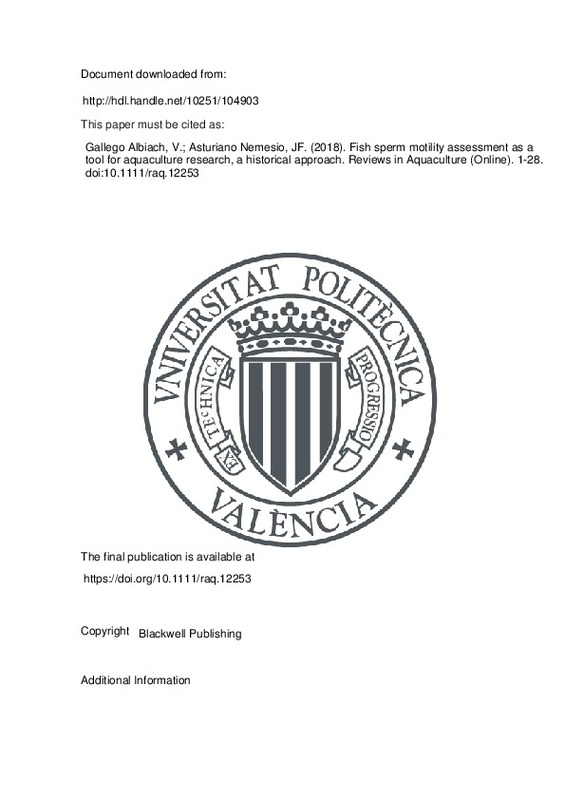JavaScript is disabled for your browser. Some features of this site may not work without it.
Buscar en RiuNet
Listar
Mi cuenta
Estadísticas
Ayuda RiuNet
Admin. UPV
Fish sperm motility assessment as a tool for aquaculture research, a historical approach
Mostrar el registro sencillo del ítem
Ficheros en el ítem
| dc.contributor.author | Gallego Albiach, Victor
|
es_ES |
| dc.contributor.author | Asturiano Nemesio, Juan Francisco
|
es_ES |
| dc.date.accessioned | 2018-07-02T04:22:28Z | |
| dc.date.available | 2018-07-02T04:22:28Z | |
| dc.date.issued | 2018 | es_ES |
| dc.identifier.uri | http://hdl.handle.net/10251/104903 | |
| dc.description.abstract | [EN] Fish sperm motility is nowadays considered the best biomarker for the quality of fish spermatozoa, and sperm motion parameters from more than 300 fish species have been reported in more than 1500 scientific articles covering a wide range of topics, from molecular biology to ecology. The most studied topics have been (i) the sperm storage (involving both the use of chilled¿storage protocols for short¿term periods and sperm cryopreservation techniques for long¿term storage), (ii) the sperm physiology (fathom in the spermatozoa activation process and the whole propulsion machinery of the sperm cells) and (iii) the broodstock management (covering aspects such as rearing conditions, dietary requirements or hormonal induction treatments). In addition, other aquaculture and ecological topics, such as (iv) the knowledge of the breeding cycle of the species, (v) the phenomenon of the sperm competition and (vi) ecotoxicological studies for the evaluation of aquatic environments, have also been approached from the evaluation of sperm motion performance. Therefore, fish sperm motility assessment can serve as a potential tool for aquaculture and ecological purposes, covering key topics of fundamental and applied research. This review gives an overview of the major research areas in which fish sperm motility has been applied successfully. | es_ES |
| dc.description.sponsorship | This project has received funding from the European Union’s Horizon 2020 research and innovation programme under the Marie Sklodowska-Curie grant agreement no. 642893 (IMPRESS). VG has a postdoc grant from the UPV (PAID-10-16). | |
| dc.language | Inglés | es_ES |
| dc.publisher | Blackwell Publishing | es_ES |
| dc.relation.ispartof | Reviews in Aquaculture (Online) | es_ES |
| dc.rights | Reserva de todos los derechos | es_ES |
| dc.subject | Kinetic | es_ES |
| dc.subject | CASA | es_ES |
| dc.subject | Sperm quality | es_ES |
| dc.subject | Spermatozoa | es_ES |
| dc.subject | Velocity | es_ES |
| dc.subject.classification | PRODUCCION ANIMAL | es_ES |
| dc.title | Fish sperm motility assessment as a tool for aquaculture research, a historical approach | es_ES |
| dc.type | Artículo | es_ES |
| dc.identifier.doi | 10.1111/raq.12253 | es_ES |
| dc.relation.projectID | info:eu-repo/grantAgreement/EC/H2020/642893/EU/Improved production strategies for endangered freshwater species./ | es_ES |
| dc.relation.projectID | info:eu-repo/grantAgreement/UPV//PAID-10-16/ | es_ES |
| dc.rights.accessRights | Abierto | es_ES |
| dc.date.embargoEndDate | 2019-05-17 | es_ES |
| dc.contributor.affiliation | Universitat Politècnica de València. Departamento de Ciencia Animal - Departament de Ciència Animal | es_ES |
| dc.description.bibliographicCitation | Gallego Albiach, V.; Asturiano Nemesio, JF. (2018). Fish sperm motility assessment as a tool for aquaculture research, a historical approach. Reviews in Aquaculture (Online). 1-28. https://doi.org/10.1111/raq.12253 | es_ES |
| dc.description.accrualMethod | S | es_ES |
| dc.relation.publisherversion | https://doi.org/10.1111/raq.12253 | es_ES |
| dc.description.upvformatpinicio | 1 | es_ES |
| dc.description.upvformatpfin | 28 | es_ES |
| dc.type.version | info:eu-repo/semantics/publishedVersion | es_ES |
| dc.identifier.eissn | 1753-5131 | es_ES |
| dc.relation.pasarela | S\364184 | es_ES |
| dc.contributor.funder | European Commission | |
| dc.contributor.funder | Universitat Politècnica de València |







![[Cerrado]](/themes/UPV/images/candado.png)

